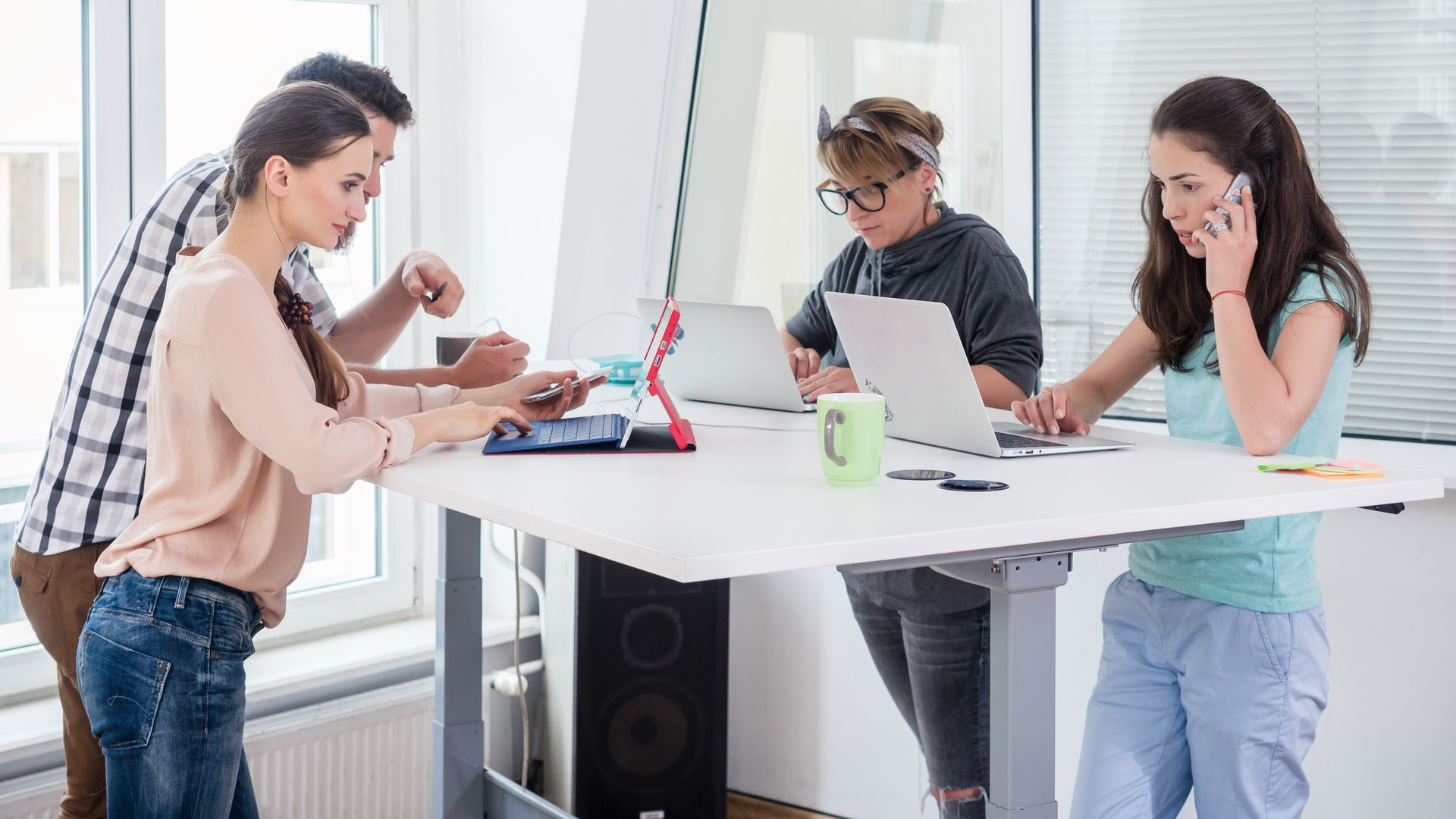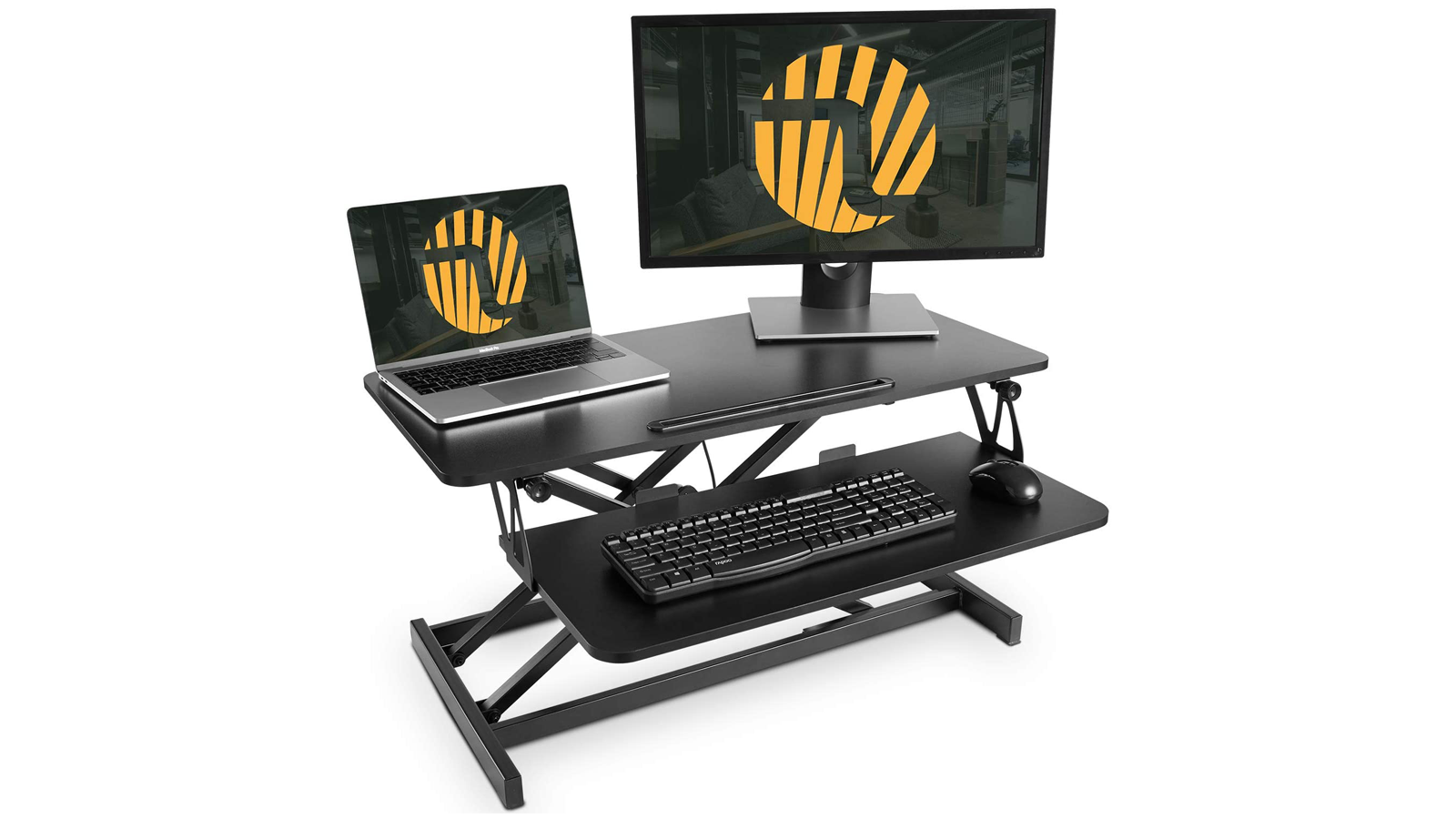Read update
- Checked content for accuracy, product availability, and dead links.
Quick Links
If your job requires you to be at your desk all day, you should consider investing in a standing desk. Why? For one, it's unhealthy to spend hours sitting. We explored the pros and cons to help you better understand the risks.
UPDATE: 9/16/22
Checked content for accuracy, product availability, and dead links.
What Is a Standing Desk?
A standing desk is one that elevates your entire workspace to allow you to work comfortably while standing up. These desks can easily hold your computer, monitors, lamps, and other desktop accessories without risk of them tipping over or falling off, and your entire work experience will remain exactly the same, except that you'll spend more time standing up.
There are a few different types of standing desks out there as well---like height-adjustable sit-stand desks and risers (we'll get into the differences down below)---so it should be easy for you to find an option that suits your style and needs.
Who Should Use a Standing Desk?
Of course, anyone who is interested in using a standing desk can (and probably should) buy one. However, standing desks are especially recommended for those who spend the majority of their day sitting at a desk, as well as those who are largely sedentary especially outside of or in addition to Monday-Friday work hours.
Having a standing desk, or even a sit-stand desk, makes it that much easier to pack a little more movement into your day. And of course, if you are going to opt for a hybrid desk that'll allow you to alternate between sitting and standing, you should help yourself out by also picking up a top-rated office chair to ensure your spine, back, and neck are taken care of when you do sit.
The Pros and Cons of Standing Desks
So now that we know that standing desks are an option, we need to consider their advantages and disadvantages. Of course, while we can discuss these and make a recommendation one way or the other, it's ultimately up to you (and your needs and budget) to make the final decision either way.
Pros
The main benefit of using a standing desk is that it helps reduce the likelihood of you developing serious health issues. Studies have linked sitting for long periods with health issues like obesity, cardiovascular disease, certain cancers, shoulder pain, back pain, diabetes, premature death, and so on. Humans are built for being upright and walking, and spending eight or more hours every day sitting down isn't exactly great for our bodies; working at a standing desk each day will do wonders for decreasing the likelihood of incurring these issues,
But the benefits don't stop there! Standing desks also do a great job of helping you burn more calories throughout the day. Even small movements like shifting your weight between your feet, fidgeting, and otherwise moving around help you burn more calories than you would if you were just sitting there. You'll also be strengthening (and possibly even toning) your leg and back muscles, which can also lead to developing better posture.
Standing desks are also linked to higher rates of productivity by as much as 45%. Users may also have better heart rates, improved energy levels, and a better mood overall than those who only sit.
Switching from sitting to standing while working at your desk is an easy change to make. And by making that change, you'll reap some undeniably remarkable benefits to your mental and physical health and even your overall well-being. Who could say no to that?
Cons
Arguably, the biggest downside to standing desks is the cost. Where regular desks only tend to run around $100-$200, standing desks can upwards of twice that. Despite all of the benefits standing desks offer, such steep prices can make them hard to justify if it's more than your budget can handle.
Because these desks are often full of moving mechanical parts, they'll always pose the risk of breaking. Even though the best standing desks are backed by a manufacturer warranty, you could still end up not having a desk for a few weeks if yours breaks and needs to be sent in for repairs.
Another concerning con is that it's not necessarily a good idea to spend all day on your feet. Studies have found that standing for long periods of time can contribute to another set of health issues, like clogged arteries, back pain, and varicose veins. But that's why sit-stand desks exist.
Which Is Best: A Sit-Stand Desk, a Standing-Only Desk, or a Riser?
Standing desks come in three varieties: There's standing-only desks, hybrid sit-stand desks, and desktop risers. While standing-only desks are certainly an option (and likely have use cases that make them a decent choice), they're not the best choice for most people.
Instead, you should go for a combination sit-stand desk or a riser. Why? They offer you the best of both worlds, letting you sit or stand whenever you want with little to no interruption to your workflow. Wondering what the difference is between the two? Let's break it down.
With hybrid sit-stand desks, the entire desktop surface---including anything you have on there like your laptop, monitors, keyboard, mouse, lamp, coffee cup, speakers, toys, and so on---is raised up all at once. Sit-stand desks are also further divided into two categories: manual and electric. Manual standing desks typically have a crank or similar device that you'll wind up manually to adjust the height, and electric standing desks do this with motors and buttons.
A riser, on the other hand, sits atop your regular old desk and you'll place things like your laptop on it (or possibly also your monitors, keyboard, and mouse if you have a large one). Your desk's actual surface will stay the same height, and only the riser and its contents will change height. Inexpensive models are typically only big enough to hold a laptop or maybe a keyboard as well. Many larger risers can take up more desk space, elevate additional items, and support more weight. It really just comes down to how much you want to spend.
How Much Should You Spend on a Standing Desk?
Standing desks can be an incredibly expensive investment, with some totaling over $5,000. Thankfully, though, there are plenty of high-quality desks at a fraction of the price that are just as good. Prices for manually adjusted desks start around $250, while motorized options start around $500.
If you're on a tighter budget, you can also opt for a desktop riser. These offer a comparable experience and typically only cost between $50 and $150.
And for what it's worth, there's no good reason to spend over $1,000 (or even just $800) on a standing desk. We recommend aiming for about $250-$300 for manual standing desks and about $500-$600 for fully electric standing desks. At these price points, you'll still get lots of bells and whistles along with a solid warranty, which is all you really need.
What Are the Best Standing Desk Accessories?
Of course, you can opt to keep things simple and just stand in front of your standing desk. Or, you can round out your setup with a few helpful accessories that'll make using your desk a little more pleasant.
We recommend an anti-fatigue mat to keep your feet from hurting while you stand. These mats are designed to take the tension out of your feet and legs, and can even eliminate cramps and massage your feet. Similarly, you can also grab a balance board, like this one from Fluidstance. Balance boards help you shift your weight around while you stand, be it through swiveling, rocking, twisting, wobbling, swaying, or otherwise fidgeting.
Likewise, if you need a quick break, but you don't want to fuss with lowering it, you can perch on a standing desk stool. These are a great way to give your feet a 15-minute break or to kick back and relax over lunch.
Final Thoughts
With multiple scientific studies showing the dangers of sitting all day sitting (even if you do have a fancy-schmancy ergonomic chair), standing desks can help mitigate the many potential health threats caused by a sedentary lifestyle. By keeping you on your toes, you can also increase your mood and energy levels.
Of course, these desks are quite pricey, especially for fully electric models. Plus, thanks to all their moving parts, they run a greater risk of breaking down than, say, a good old-fashioned desk does. It can also be just as rough on your body to spend all day on your feet.
That said, the benefits of standing desks far outweigh any disadvantages, especially for folks who struggle to remain up and active throughout the day. As such, we recommend choosing a sit-stand desk, either a manual or automatic model. These will let you alternate between sitting and standing as needed, and make it easier to move around and stay healthy while you work.
Feeling ready to buy a standing desk? Check out our favorite affordable standing desks to explore all of your many options, from simple risers to manual crank and adjustable electric standing desks.




